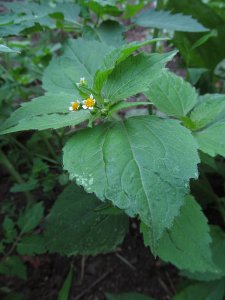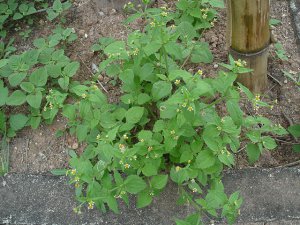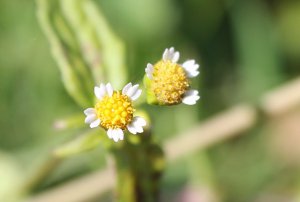Introduction to Galinsoga parviflora
Galinsoga is an annual plant that is known for rather an infamous reason: how invasive it is. It is rare to have a plant commonly referred to by its scientific name, but galinsoga has multiple other names, including guasca, mielcilla, gallant soldier, quick weed, and potato weed. Galinsoga grows in disturbed areas, spreading quickly throughout temperate and subtropical areas via seed pollination. This plant is native to Central and South America, the earliest known origins were documented in Peru, and has since naturalized around the entire world, including the household garden.

Identifiers and Look-a-likes
Galinsoga is a broad-leaved plant that has a shallow root system, so the plant is easier to harvest. However, the plant also is seed propagated with small flowers that bloom from the stem tips. These flowers can blossom in white, pink, and red, and release multiple tiny seeds that quickly germinate to produce the next generation of galinsoga. These flowers will bloom from October to April, and the plants will continue to germinate future plants even after the first frost has passed.
Galinsoga is a member of the Aster family, which has multiple toxic varieties that look similar to the non-toxic galinsoga. One such toxic look-a-like is the white snakeroot (Ageratina altissima) plant, which is a poisonous perennial that shares the characteristic of blooming small, white flowers in the autumn. White snakeroot is also seed propagated, which its seeds are most often spread due to the wind and insects. One non-toxic look-a-like is the Galinsoga quadriradiata, known as “hairy” galinsoga. Two main differences between the two varieties are that hairy galinsoga flowers are often white, yellow, or gold and that the leaves have fibrous hairs on them.

Ways to Use Galinsoga
In the past, galinsoga has been known as a “famine” food, as while the edible parts are nutritional, they are also known to taste rather bland. This plant can be eaten raw or cooked, but there has been some debate surrounding the safety of consuming galinsoga raw, so do be sure to start small at first. Galinsoga has also been recognized as a “pot herb”, as the taste has been said to increase after the leaves and stems have been cooked, and were most commonly used in a soup called ajiaco, a Colombian potato soup. This brief culinary history may also be the reason behind galinsoga’s alternative name, potato weed.
Nutrients found within galinsoga include calcium, magnesium, potassium, and zinc. This plant has also been shown to contain sustainable amounts of vitamins A, C, and B1, B2, and B3. Galinsoga is also comparable to dark greens, such as spinach, as the wild edible contains three grams of protein. Because of how nutritional beneficial this plant is, galinsoga has also been popularly used as a flavoring in cooking. By drying the plant parts, they can be then ground down into a powder. Although the overall flavor of galinsoga has been described as bland, the flavor, when cooked, transforms into a subtle artichoke-like flavor.
Outside of its’ nutritional and culinary uses, galinsoga has been reported to have been used as a remedy for treating nettle stings and bleeding, therefore known for its astringent properties. Other ailments that galinsoga has been noted to be used include vomiting, snake bites, diabetes, and high blood pressure. According to research, galinsoga has been found to contain ACE inhibitors, which help to increase blood flow and help to regular blood pressure. Other conditions that galinsoga has been noted to help include inhibiting hyperglycemia, hypertension associated with Type 2 diabetes, in addition to containing antioxidants.

Because galinsoga is known to spread quickly, the plant can grow in mass quantities and provide a lasting supply. Even though the plant is a secure species, it is a good idea to be mindful when harvesting as to not disrupt the local environs, as well as to be mindful of the seeds. If you happen to bring a few seeds back home, you might find an even closer source sprouting nearby.
—————Written by Jordyn Lee
Jordyn Lee is a freelance writer with a background in herbalism and a passion for sustainable living. She has a Bachelor's degree in Communication Studies and continues to learn more about health and nature. Connect with her on (LinkedIn) or Freelancer Profile (upwork.com).
Many of our readers find that subscribing to Eat The Planet is the best way to make sure they don't miss any of our valuable information about wild edibles.
See our privacy policy for more information about ads on this site







One Response
Hi, don’t you mean the flowers bloom from April to October?